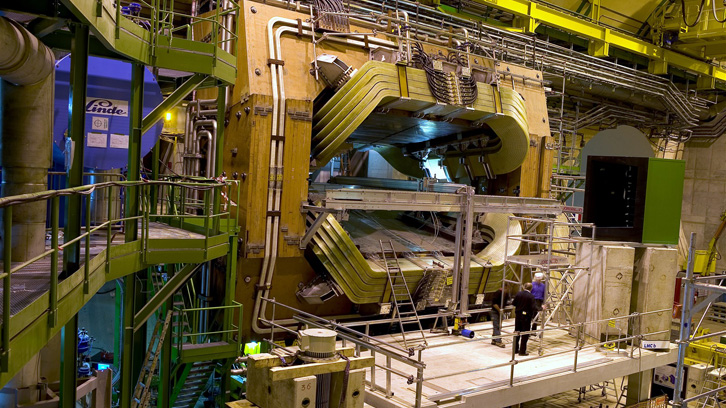Tightening the grip on New Physics

What is ultimately the world made of? Can we understand all the matter that surrounds us and makes us in terms of simple building blocks and a few simple laws? The main goal of particle physics is to answer these questions and to understand Nature at its most elementary level. The most recent and accurate description, called the « Standard Model » (or SM), received a remarkable confirmation in 2012 with the discovery of the H boson at the ATLAS and CMS experiments at the Large Hadron Collider (CERN, Geneva). In spite of its success, the SM is known not to be the final answer because it leaves many deep questions unanswered. A more fundamental theory, from which the SM would stem, is needed to solve these issues: the consequences of such more fundamental theory are currently actively looked for at the LHC, and are generically nicknamed as « New Physics ».
In the past years, at the LHC and in earlier experiments (called B factories), physicists have started to probe the SM in decays of particles never observed before and at energies never explored up to now. As a result a series of deviations with respect to the SM predictions has come up into light. Particle accelerators produce short-lived particles that quickly decay into lighter particles, with different probabilities. Some of these decays happen rarely in the SM and can thus be affected more easily by the possible presence of the evasive New Physics. Such « rare decays » are a powerful tool to explore physics beyond the SM.
In July 2013 at the international high-energy physics EPS conference in Stockholm, the LHCb experiment (CERN, Geneva) presented for the first time measurements of one particular rare decay, using quantities describing the geometry of the decay and designed to be particularly sensitive to New Physics. These observables were proposed and computed in the SM by a team of researchers at UAB and CNRS formed by the professor of Physics at UAB Joaquim Matias, Sebastien Descotes-Genon director of LPT Orsay (CNRS and Univ. Paris-Sud, France), and Javier Virto currently postdoc at Bern University (Switzerland). The group now is enlarged with L. Hofer (UB) and B. Capdevila (IFAE). The results indicated a large deviation from the SM prediction for the so-called P5’ quantity, hinting at the presence of New Physics.
These results have led to considerable interest from theorists and experimentalists, triggering new developments. On the theory side, alternatives to explain the « P5’ anomaly » within the SM have been discussed extensively. “Even if we could not find a convincing explanation within the SM with our present knowledge, we have gone further and proposed new tests free from SM uncertainties, in order to probe the emerging pattern of deviations”, explains J. Matias.
On the experimental side, a plethora of news has indeed arrived. LHCb confirmed the P5’ anomaly observed in 2013 with a larger set of data in March 2015 at the Moriond. The Belle experiment (KEK, Tsukuba, Japan) reanalysed the stored data a few months ago and confirmed the observation made by LHCb. Both experiments have analysed other rare decays with surprising consequences. They observed no clear deviations from the SM for decays involving electrons, but they noticed significant deviations for similar decays involving their more massive cousins, the muons and the taus. Such differentiated behaviour cannot be ascribed to effects from the SM, where all three types of leptons (electrons, muons and taus) are treated on the same footing: this « lepton flavour universality » would be broken according to these recent experimental results.
The best way to understand these deviations consists in analysing all these decays in a single global framework. It turns out that simple hypotheses on the nature of New Physics allow to explain all these deviations elegantly, as confirmed by several groups of theorists analysing the data. Some trendy New Physics models to explain these anomalies introduce a new interaction (transmitted by a Z’ boson) or a new kind of matter particle (so-called leptoquark).
A very interesting result from Belle has just been announced at the international CKM conference in December 2016 in Mumbai (India). « They implemented the new test that we proposed and they found an interesting hint, though not with any statistical significance yet, that muons seem to be affected by New Physics effects much more than electrons » comments J. Matias. If confirmed with enough significance by the LHCb experiment and/or the forthcoming Belle-II experiment, this tantalising result could lead to a clear evidence for New Physics. This would trigger a major change in the way we understand elementary particles.
Undoubtedly exciting times are ahead for the theory groups and the experimental teams from the LHCb, Belle and CMS experiments that are joining forces to crack this Nature’s puzzle.
References
Angular analysis of the B->K* mu+mu- decay using 3 fb^{-1} of integrated luminosity, R. Aaij et al. (LHCb Collaboration). JHEP 1602 (2016) 104. (confirmation of the anomaly in P5' in 2015)
Global analysis of b->sll anomalies, S. Descotes-Genon, L. Hofer, J. Matias, J. Virto, JHEP 1606 (2016) 092. (global analysis pointing to tensions above 4.5sigma)
Assessing lepton-flavour non-universality from B->K*ll angular analyses, B. Capdevila, S. Descotes-Genon, J. Matias, J. Virto. JHEP 1610 (2016) 075. (our proposal of complementary test)
Angular analysis of B0->K*(892) l+l-, A. Abdesselam et al. (Belle Collaboration), arXiv: 1604.04042. (confirmation of the anomaly in P5' by Belle in 2016)
Lepton-Flavour-Dependent Angular Analysis of B->K*l+l-, S. Wehle et al. (Belle Collaboration). arXiv: 1612.05014. (first result on the test albeit with very low statistics)


